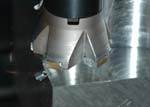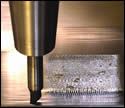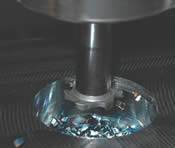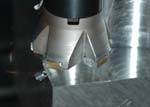Faster Cavity Roughing
Fresh eyes and replaceable-tip cutters triple moldmaker’s cavity roughing rate.
These days, domestic mold and die shops make it or not based largely on how fast they can hog out tool cavities. Faster cavity roughing gets the whole tool set out the door sooner, enabling you to compete better against offshore shops while still preserving your margins.
So when you find a way to double or triple your cavity roughing rate, you jump on it.
That’s exactly the case at B&J Specialty (BJS) in Wawaka, IN, which focuses on larger mold and die sets for the appliance and automotive industries. Today they’re roughing hardened A-2 die stock twice as fast as before. Moreover, they’re hogging out cavities in wrought H-13 and M-4 mold stock three times faster.
BJS process engineer Scott Sizemore had a hunch he could be roughing faster than 80 ipm if only he could find a cutter able to stand up. After all, their Makino V 550 vertical mill with a 20,000-rpm spindle had higher feed to spare. But whenever he turned up the feed, the solid carbide ball nose mill he was using—at $90 a pop—dulled out in just minutes. “Shows you what a fresh set of eyes can do,” says Sizemore, who led the change.
First Impression
The fresh eyes belonged to Mitch Bair, a representative from Ingersoll Cutting Tools recently assigned to this account and looking to make a good first impression. Sizemore showed him the cavity roughing operation with the ball nose mill and challenged him to come up with a better way.
“It was one of our bottleneck operations, so any improvement here would benefit the whole enterprise,” explains Sizemore. “If we go to the trouble to re-tool, we’d better make it count.”
After studying the operation, Bair suggested that a recently introduced Ingersoll Chip-Surfer high-feed bull nose cutter with replaceable tips would improve the roughing rate on soft stock by at least three to one and reduce tooling costs to boot. For roughing the hardened A-2 stock (Rc 60), Bair recommended an Ingersoll toroidal cutter, projecting at least 60 percent higher throughput.
Tests Point the Way
Then he brought B&J the two tools to test on their own, with suggested settings. For roughing the soft wrought H-13 and M-4 steel, he suggested 6800 rpm, a 600-700 ipm feedrate and a slightly shallower depth-of-cut (DOC): 0.020 in. vs. 0.050 in. with the ball nose mill. For the toroidal cutter on hard A-2, he suggested 200 ipm/0.012" DOC, or twice the feed and three times the DOC as before, at the same 3750 rpm as before.
The next week, Sizemore tested the high-feed bull nose Chip Surfer at 600 ipm/0.020 DOC on the wrought mold stock. Spindle speed was 6800 rpm, unchanged from before. The tip was still sharp after an hour in the cut, which was how long the old solid carbide cutter has lasted—while cutting at only 80 ipm. He changed the tip anyway, a 20-second job with the Chip-Surfer shank still chucked in the spindle, and started right up again. With in-spindle tip changing, there’s no downtime touching off or reprogramming datum references.
Doing the math, Sizemore concluded that he had found the solution for one bottleneck operation. The bottom line: 3.3 times faster material removal on wrought mold stock and three times longer service life of a cutting tip costing about 40 percent less than the cutter it replaces. The time saving for edge changing—20 seconds from STOP to START vs. five minutes before—was simply icing on the cake.
Tests with the toroidal cutter on Rc 60 steel were just as conclusive.
The cutter lasted a full hour in the cut, the same as before, but after feeding 4.5 times faster for the entire hour. The toroidal cutter made chips at 3750 rpm/175 ipm/0.012" DOC, vs. 3750/100/0.004" before.
“While even a small percentage gain in rough-milling throughput would be important, here we’re talking order-of-magnitude increases, on both the wrought and hardened steels,” says Sizemore.
Pushing the Envelope
Not surprisingly BJS has standardized on the Ingersoll cutters for all their rough and semi-finish milling of mold and die cavities. But Sizemore didn’t stop there. He inched up the speed settings over those used in the validation test. Result: BJS now feeds the Chip Surfer high-feed bull nose cutter at 700 ipm and the toroidal cutter at 200 ipm with no loss of tool life or surface finish quality.
“We’re literally roughing 3.5 times faster and finishing six times faster than before with similar gains in edge life per unit of material removed,” says Sizemore. “In effect, eliminating this bottleneck has increased capacity of the shop as a whole, and enabled us to quote better deliveries. That gives us a key competitive edge over offshore shops ten thousand miles away that use lower technologies. We also can quote price with a sharper pencil and still maintain margins.”
Geometry Matters
Higher cutting rates with the Chip Surfers stem directly from their advanced geometry. First, the tool silhouettes are more straight-sided and cylindrical than spherical as with ball nose cutters. The pitch radius, and therefore the surface cutting speed, is more uniform over the entire cutting surface. Surface speed doesn’t approach zero as it must near the nose of a ball nose mill. Next, a robust sweeping radius capitalizes on chip thinning for faster removal on straight cuts. Generous corner radius and backdraft combine to facilitate cleaning out corners and minimize cutting forces. Finally, the tough alloy shank withstands shock and side deflection better than brittle solid carbide cutters.
And for milling the hard steels, the Ingersoll toroidal cutter boasts some of the same design differences over ball nose mill cutters, and more. The toroidal cutter also features six flutes instead of four, permitting 50 percent higher feeds without increasing cutting forces per flute. And again the radius is essentially constant over the entire cutting surface—keeping surface speed more uniformly optimized. With the shallow cuts characteristic of milling hard metals, this is a tremendous advantage.
The tool design also recognizes that efficient cavity milling is essentially side milling, which involves higher lateral forces. The alloy tough shank handles lateral forces that would snap off a solid carbide cutter.
Related Content
Maintaining a Wire EDM Machine
To achieve the ultimate capability and level of productivity from your wire EDM on a consistent, repeatable and reliable basis, regular maintenance is a required task.
Read MoreAdvantages and Disadvantages of Copper and Graphite Electrodes
Both copper and graphite provide approximately the same end result, so it is important for a shop to consider the advantages and disadvantages of each material in order to discover what would work best in their shop floor environment.
Read MoreThe Benefits of Hand Scraping
Accuracy and flatness are two benefits of hand scraping that help improve machine loop stiffness, workpiece surface finish and component geometry.
Read MoreLaser Welding Versus Micro Welding
The latest battle in finely detailed restoration/repair of mold materials.
Read MoreRead Next
Determining the Value Of Your Cutting Tool
How to reach the break even point of your cutting tool investment within hours.
Read MoreHow to Retain Pin Bushings
Simplify pin-bushing retention and reduce machining time by four to one for each bushing hole by implementing a new process.
Read MorePlunge Milling Saves Time on Big Mold Cavities
By using a plunge mill, what used to take four hours now takes only 30 minutes—and stretches mold feedstock.
Read More









.png;maxWidth=300;quality=90)


.jpg;maxWidth=300;quality=90)



















